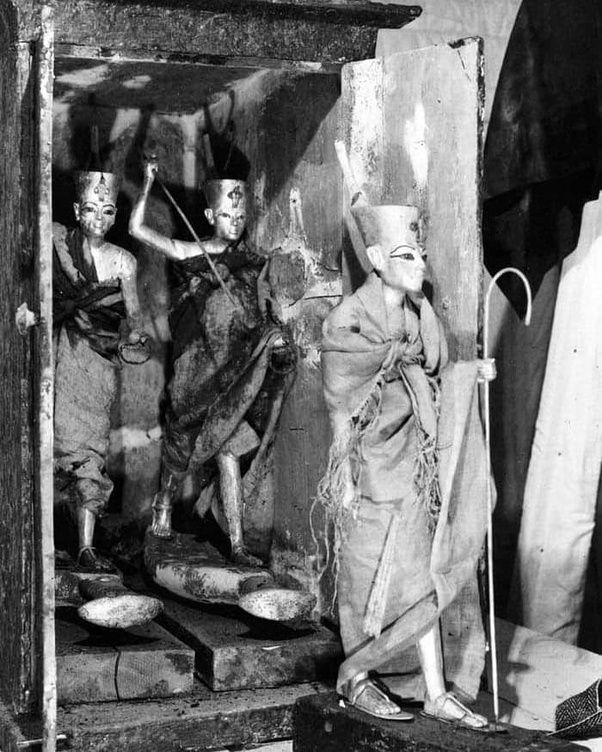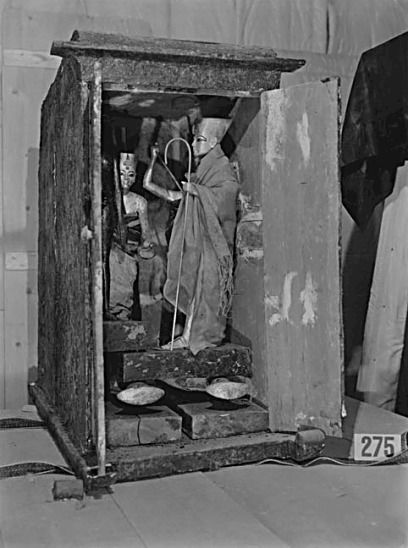In 1922, British archaeologist Howard Carter made an extraordinary breakthrough that would forever change the field of archaeology: the discovery of the tomb of Pharaoh Tutankhamun. After years of diligent exploration in Egypt’s Valley of the Kings, Carter and his team uncovered a long-lost burial site that had remained hidden for over three millennia. The iconic photograph capturing Carter’s awe at the tomb’s entrance, as he gazed upon its treasures, encapsulates the moment of wonder and excitement that marked the beginning of a groundbreaking excavation.
An Unmatched Discovery: Preservation and Riches Beyond Imagination
What set the discovery of Tutankhamun’s tomb apart was the exceptional preservation of its contents. Unlike many other tombs in the Valley of the Kings, which had been looted over the centuries, this one had remained untouched by tomb robbers. Inside, Carter uncovered a wealth of priceless artifacts, including golden treasures, intricate jewelry, and the remarkably well-preserved mummy of the young pharaoh. These findings offered an unparalleled glimpse into the life and death of an ancient ruler, shedding light on the cultural, religious, and historical aspects of ancient Egyptian civilization.

Notably, among the most celebrated discoveries was the golden mask of Tutankhamun, which has since become one of the most iconic symbols of ancient Egypt. The mask, made of solid gold and weighing over 20 pounds, features exquisite detailing and represents the divine status of the king. It is not only a masterpiece of ancient craftsmanship but also a symbol of the wealth and artistry of the New Kingdom period.
Artifacts with a Deeper Significance: Exploring Ancient Egyptian Beliefs
The treasures found within the tomb were not just symbols of wealth but also representations of the ancient Egyptian belief in the afterlife. The tomb contained items meant to accompany the pharaoh on his journey into the next world. These included ceremonial chariots, weapons, and a golden throne. These items, combined with the mummy itself, revealed much about the rituals and practices that surrounded royal burials in ancient Egypt.
The tomb was designed to ensure that Tutankhamun would be well-equipped for the afterlife, reflecting the Egyptians’ view that death was not an end but a transition into another world. These artifacts also provided insight into the role of the pharaoh as both a political and religious leader, responsible for maintaining cosmic order (maat) and ensuring the prosperity of Egypt.
Carter’s Documentation: Shaping Our Understanding of Ancient Egypt
Carter’s meticulous documentation of the excavation process, including photographs that have become iconic in their own right, allowed the world to follow the discovery as it unfolded. The excitement surrounding this unprecedented find reignited global interest in Egyptology and deepened our understanding of ancient Egypt’s burial customs, art, and wealth.

Through his detailed records, Carter was able to preserve an invaluable archive of images and notes that have been used by scholars to piece together the cultural and historical context of the tomb’s contents. The discovery provided new perspectives on the political and cultural life of Egypt during Tutankhamun’s reign, which had previously been known only through fragmented historical texts.
The presence of specific artifacts, such as the tomb’s treasure and religious symbols, pointed to the importance of Tutankhamun’s brief reign, even though he was not one of Egypt’s greatest rulers. It also suggested that his tomb may have been intended to reflect a larger political message about the legitimacy of his rule and the divine right of kings.
A Lasting Legacy: King Tut’s Influence on Modern Archaeology
The unearthing of King Tut’s tomb remains one of the most significant milestones in archaeological history. It inspired a global fascination with ancient Egypt and continues to fuel scholarly inquiry into the civilization’s legacy. The tomb’s treasures, preserved so remarkably, gave the world a rare and intimate look into ancient Egypt’s royal life, culture, and religious beliefs.
The excitement surrounding the discovery not only propelled Egyptology into the global spotlight but also led to the development of more sophisticated archaeological methods. The careful, scientific approach Carter took in documenting and excavating the tomb set new standards for the field, influencing how archaeological digs are conducted to this day.
Conclusion: The Enduring Allure of King Tutankhamun’s Tomb
The tomb of King Tutankhamun is a testament to the enduring allure of Egypt’s past, offering invaluable insights into the ancient world. The discovery has ensured that the young pharaoh’s name, once forgotten by history, will never be lost again. The artifacts and the tomb itself continue to captivate audiences worldwide, offering a rare window into a civilization that thrived over 3,000 years ago.
King Tutankhamun’s tomb remains an enduring symbol of the richness and complexity of ancient Egyptian culture, and the ongoing study of his tomb and its treasures continues to inspire curiosity and fascination, ensuring that the legacy of this extraordinary discovery lives on.

